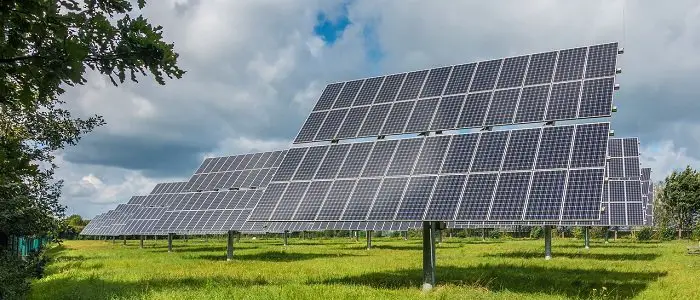Looking to invest in renewable energy? You’re in the right place! In this article, we’ll guide you step by step on how to invest wisely in the renewable energy sector. Whether you’re a seasoned investor or just starting out, we’ve got you covered. Investing in renewable energy not only helps combat climate change but also presents a lucrative opportunity to grow your wealth. So, let’s dive right in and explore how to make the most of this promising investment avenue. Ready to learn how to invest in renewable energy? Let’s get started!
How to Invest in Renewable Energy: A Comprehensive Guide
The Growing Importance of Renewable Energy
Renewable energy has become an increasingly hot topic in recent years, as the world faces the urgent need to reduce greenhouse gas emissions and combat climate change. Investing in renewable energy not only helps protect the environment but also offers lucrative opportunities for individuals and businesses alike. This comprehensive guide will walk you through the various aspects of investing in renewable energy, from understanding the different types of renewable energy sources to evaluating investment options and assessing risks.
Understanding Renewable Energy Sources
Before delving into the investment opportunities, it’s crucial to understand the different types of renewable energy sources available:
1. Solar Energy:
– Solar panels convert sunlight into electricity, making solar energy one of the most popular and accessible forms of renewable energy.
– Rooftop solar panels, solar farms, and large-scale solar power plants are common investment avenues in the solar energy sector.
2. Wind Energy:
– Wind turbines harness the power of wind to generate electricity.
– Onshore and offshore wind farms are the primary investment options for wind energy.
3. Hydroelectric Power:
– Hydroelectric power utilizes the force of flowing water to generate electricity.
– Large-scale hydroelectric dams and small-scale micro-hydro systems offer investment opportunities in this sector.
4. Biomass Energy:
– Biomass energy is derived from organic matter such as wood, crop waste, and animal manure.
– Investing in biomass power plants and biofuel production facilities is common in this sector.
5. Geothermal Energy:
– Geothermal energy harnesses heat from the Earth’s core to generate electricity and heat buildings.
– Geothermal power plants and geothermal heating systems are viable investment options.
Benefits of Investing in Renewable Energy
Investing in renewable energy brings a multitude of benefits, including:
1. Environmental Sustainability:
– Renewable energy sources produce little to no greenhouse gas emissions, reducing our carbon footprint and mitigating climate change.
– Choosing renewable energy over fossil fuels helps preserve natural resources and ecosystems.
2. Diversification of Investment Portfolio:
– Adding renewable energy investments to your portfolio provides diversification, reducing exposure to volatile sectors such as oil and gas.
– Renewable energy investments tend to be less correlated with traditional market trends, offering stability in uncertain economic times.
3. Long-Term Cost Savings:
– Many renewable energy projects offer long-term cost savings, particularly through reduced energy bills.
– For example, installing solar panels on your property can offset or even eliminate your electricity costs over time.
4. Job Creation and Economic Growth:
– Investing in renewable energy stimulates job creation and economic growth, as the sector requires skilled professionals across various industries.
– Green energy investments contribute to a more sustainable and resilient economy.
Evaluating Investment Opportunities
When it comes to investing in renewable energy, there are several factors to consider:
1. Research and Due Diligence:
– Thoroughly research the renewable energy sector, including market trends, technological advancements, and regulatory policies.
– Conduct due diligence on the specific projects or companies you are considering, evaluating their financial viability, track record, and management team.
2. Assessing Risk and Returns:
– Like any investment, renewable energy carries risks. Evaluate factors such as resource availability, technological risks, market demand, and regulatory stability.
– Consider potential returns, including dividends, capital appreciation, tax credits, and other incentives relevant to the jurisdiction.
3. Investment Vehicles:
– Renewable energy investments can take various forms, including stocks, bonds, mutual funds, exchange-traded funds (ETFs), and direct project investments.
– Determine which investment vehicle aligns with your risk tolerance, time horizon, and investment goals.
4. Geographic Considerations:
– Different regions offer unique opportunities and challenges in renewable energy investing.
– Take into account factors such as available resources, government policies, electricity prices, and local market dynamics.
Government Incentives and Policies
Governments worldwide are implementing a range of incentives and policies to promote renewable energy investment. These include:
1. Feed-in Tariffs (FITs):
– FITs guarantee a fixed payment for renewable energy producers, stimulating investment in renewable projects.
– Producers can sell excess energy back to the grid at predetermined rates, ensuring a stable revenue stream.
2. Investment Tax Credits (ITCs):
– ITCs provide tax incentives to individuals or businesses investing in renewable energy projects.
– They allow for deductions or credits on income or corporate taxes, reducing the overall investment cost.
3. Renewable Portfolio Standards (RPS):
– RPS require utilities to obtain a certain percentage of their energy from renewable sources.
– This policy drives increased demand for renewable energy, creating opportunities for investors.
4. Green Bonds:
– Governments and organizations issue green bonds to finance renewable energy projects.
– These bonds provide attractive returns while allowing investors to support sustainable initiatives.
Managing Risks in Renewable Energy Investments
As with any investment, it’s essential to consider and manage risks in renewable energy investing. Some common risks include:
1. Regulatory and Policy Changes:
– Governments may alter incentives, subsidies, or regulations, impacting the financial viability of renewable energy projects.
– Stay informed about policy changes and assess their potential impact on your investments.
2. Technology Risks:
– Rapid technological advancements can render certain renewable energy technologies obsolete.
– Evaluate the maturity and scalability of technologies before investing.
3. Resource Availability:
– Renewable energy projects require access to consistent and reliable resources, such as sunlight or wind.
– Conduct thorough assessments of resource availability before committing to investments.
4. Financial Viability:
– Assess the financial stability and track record of project developers or companies you are considering for investment.
– Evaluate factors such as debt levels, cash flow, and revenue projections.
Investing in renewable energy presents a significant opportunity to contribute to a sustainable future while generating financial returns. By understanding the various renewable energy sources, evaluating investment opportunities, considering government incentives and policies, and managing risks, you can make informed decisions and become part of the clean energy transition. Embracing renewable energy investments not only benefits the environment but also offers the potential for long-term growth and stability in your investment portfolio.
A new way to invest in clean energy innovation: Breakthrough Energy Catalyst
Frequently Asked Questions
Frequently Asked Questions (FAQs)
What are some ways to invest in renewable energy?
Investing in renewable energy can be done through various avenues, including:
– Directly purchasing shares in renewable energy companies.
– Investing in renewable energy-focused mutual funds or exchange-traded funds (ETFs).
– Participating in crowdfunding projects that support renewable energy initiatives.
– Installing renewable energy systems, such as solar panels, on your property.
– Investing in green bonds that finance renewable energy projects.
What factors should I consider before investing in renewable energy?
Before investing in renewable energy, it’s important to consider:
– The potential return on investment and financial viability of the project or company.
– The location and availability of renewable energy resources in the area.
– The regulatory landscape and government incentives supporting renewable energy.
– The long-term sustainability and growth prospects of the industry.
– The track record and reputation of the company or project developers.
How can I assess the financial performance of a renewable energy company?
To assess the financial performance of a renewable energy company, you can:
– Review their financial statements, including revenue, expenses, and profitability.
– Analyze their cash flow statement to understand their ability to generate cash.
– Look for information on their debt levels and financing arrangements.
– Evaluate their return on investment (ROI) and compare it to industry benchmarks.
– Consider any relevant market factors and trends affecting the company’s financial health.
Are there any risks associated with investing in renewable energy?
Like any investment, investing in renewable energy carries certain risks, such as:
– Market volatility and fluctuations in renewable energy prices.
– Regulatory changes and shifts in government policies.
– Technological advancements that could make certain renewable energy technologies obsolete.
– Environmental factors, such as natural disasters, that could damage infrastructure.
– Project-specific risks, such as delays, cost overruns, and construction issues.
Can I invest in renewable energy if I have a limited budget?
Yes, even with a limited budget, there are investment options available in renewable energy, such as:
– Investing in renewable energy-focused ETFs or mutual funds, which allow you to diversify your investment with a smaller initial amount.
– Participating in crowdfunding projects that often have lower investment thresholds.
– Considering community solar projects that allow individuals to pool resources and invest collectively.
– Exploring peer-to-peer lending platforms that connect investors directly with renewable energy projects seeking funding.
How can I stay updated on the latest developments and opportunities in renewable energy investing?
To stay informed about renewable energy investment opportunities, you can:
– Follow reputable industry publications and news outlets that cover renewable energy topics.
– Attend conferences, webinars, and seminars focused on renewable energy.
– Join online forums or communities dedicated to renewable energy investing.
– Subscribe to newsletters or mailing lists of renewable energy companies or investment firms.
– Consult with a financial advisor who specializes in sustainable investing.
Are there any tax benefits associated with investing in renewable energy?
Yes, in many countries, there are tax benefits and incentives available for investing in renewable energy, such as:
– Tax credits or deductions for installing renewable energy systems on your property.
– Tax incentives for investing in renewable energy projects, such as production tax credits or investment tax credits.
– Accelerated depreciation allowances for renewable energy infrastructure.
– Exemptions or reduced tax rates for income generated from renewable energy investments.
– Consult with a tax professional or financial advisor to understand the specific tax benefits available in your jurisdiction.
What are the potential long-term benefits of investing in renewable energy?
Investing in renewable energy can offer several long-term benefits, including:
– Positive environmental impact by reducing greenhouse gas emissions and reliance on fossil fuels.
– Potential for stable and predictable returns as renewable energy becomes more mainstream.
– Diversification of investment portfolio by entering a growing sector with significant potential for growth.
– Contribution to regional economic development through job creation and local infrastructure investment.
– Alignment with sustainability goals and values, attracting socially responsible investors.
Final Thoughts
Investing in renewable energy presents an opportunity for both financial gain and environmental sustainability. To start investing in this sector, it is important to educate yourself about the different types of renewable energy sources and their potential returns. Conduct thorough research on renewable energy companies and funds that align with your investment goals. Diversify your portfolio by investing in a mix of renewable energy technologies. Consider investing in green bonds or exchange-traded funds (ETFs) that focus specifically on renewable energy. Engage with experts and seek professional advice to make informed investment decisions. By investing in renewable energy, you contribute to a brighter and cleaner future while potentially generating attractive returns. So, if you’re looking to invest in renewable energy, start by researching the available options and aligning your investments with your financial and environmental goals.



